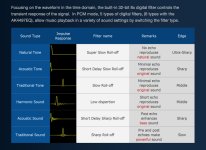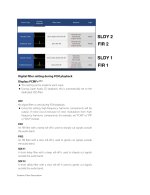Mr Peabody
Well-known member
- Thread Author
- #1
My DAC provides 3 filters. In reading about them and trying to find information I found it a bit confusing, no place really broke down what I was looking for. So feel free to correct me if I'm wrong, a source would be appreciated, remember I'm in the "Show-Me" state.
There's talk of this ringing but not much explanation. Supposedly, some are sensitive to it. I believe I'm one of those unless it's just the difference in what the filter does.
I have a "fast" filter which is a quick roll off and I believe this causes pre and post ringing but very linear and less distortion.
A "slow" filter where the high frequency cutoff slope is slow but no ringing.
Then there's a "minimal phase" filter with only post ringing. I don't know what is meant by minimal phase, the other two seem to have to do with how steep the cutoff slope is.
Unfortunately, no switching on the fly. I found the DAC set to "fast". It sounds good like that. I set it to "slow" and immediately liked that better. I haven't tried the other one yet but from what I hear with the "slow" I think I'm set. I didn't realize anything was wrong when I listened to "fast" but when "slow" is engaged it's just easier to listen to. Some may call It more analog. I find it less piercing, lack of a better word. All the detail is there, it's just easier to take in and sounds more natural.
Any experience with filters on your gear or knowledge to share?
There's talk of this ringing but not much explanation. Supposedly, some are sensitive to it. I believe I'm one of those unless it's just the difference in what the filter does.
I have a "fast" filter which is a quick roll off and I believe this causes pre and post ringing but very linear and less distortion.
A "slow" filter where the high frequency cutoff slope is slow but no ringing.
Then there's a "minimal phase" filter with only post ringing. I don't know what is meant by minimal phase, the other two seem to have to do with how steep the cutoff slope is.
Unfortunately, no switching on the fly. I found the DAC set to "fast". It sounds good like that. I set it to "slow" and immediately liked that better. I haven't tried the other one yet but from what I hear with the "slow" I think I'm set. I didn't realize anything was wrong when I listened to "fast" but when "slow" is engaged it's just easier to listen to. Some may call It more analog. I find it less piercing, lack of a better word. All the detail is there, it's just easier to take in and sounds more natural.
Any experience with filters on your gear or knowledge to share?


